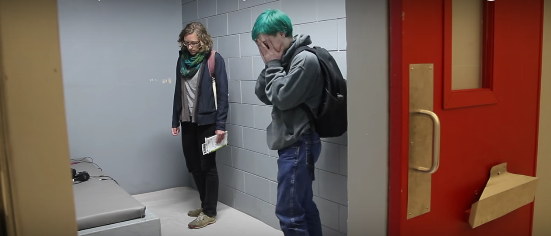






While the nation faces changes to solitary confinement for juveniles, Madison nonprofit groups have been working to eliminate the practice altogether, citing it as contrary to our human nature, especially for those with mental health issues.
“The realities of being trapped like that with nothing to do and nowhere to go - it’s probably unfathomable to you,” Minister Caliph Muabel said. “Striving to keep your sanity and trying to find ways to feel like a human being again... those are challenging things weighing on your heart and mind.”
Muabel spent ten years in solitary confinement in the Dane County jail.
Now he is part of an activist group in Madison called called Ex-Prisoners Organizing. Groups like Ex-Prisoners Organizing and Madison Organizing in Strength, Equality and Solidarity (MOSES) are working to end solitary confinement completely in Wisconsin.
Muabel shared his story at an Experience Solitary Confinement event at Central Library in November. The event featured a replica solitary confinement cell, complete with a live audio recording from a cell in Wisconsin.
“There is almost constant noise because people begin to lose their minds,” solitary confinement reform activist Carol Rubin said. “We are social animals and we are unable to deal with that isolation.”
Rubin helped found MOSES, a non-partisan, interfaith collaboration of congregations, non-profits and individuals working to reform public policy that affects the criminal justice system.
“Many people sent to solitary are sent there because they are mentally ill and have a hard time conforming to the requirements of prison cells,” Rubin said.
Conditions inside a solitary confinement cell are bleak. Prisoners are trapped in a small room with only a thin mattress pad and nothing to do for 23 to 24 hours-a-day. They have little to no natural light or relationship to the outside world. In addition to the constant noise the fluorescent lights remain on at all times.
According to a United Nations expert, 15 days or more in solitary confinement is torture. Rev. Jerry Hancock of the Prison Ministry Project cited a statistic from the Wisconsin Department of Corrections that more than 4,000 inmates, roughly 20 percent of the total inmate population, were placed in solitary confinement at some point between Dec. 2011 and Dec. 2012.
Based on these statistics, Rev. Hancock concluded that “the use of torture is very much part of the policy of the Department of Corrections in Wisconsin.”
Rev. Hancock said the state government – the Department of Corrections and the governor – have been unresponsive. “They have refused to meet with us and other advocates of reform on a range of criminal justice issues,” he said.
Activists at the Experience Solitary Confinement event compared Wisconsin to Minnesota which have similar demographics but vastly prison statistics. According to The Sentencing Project, Minnesota has a total of 17,312 people incarcerated in prison and jail compared to Wisconsin’s 35,589 in 2013. In 2013, Wisconsin’s state expenditures on correctional facilities are 2.5 times higher than Minnesota’s.
Activists also discussed how correctional facilities aren’t being used for correctional purposes, but rather for punishment. This is particularly concerning in regards to inmates with mental health issues.
Madison Police Mental Health Liaison Capt. Kristen Roman said the conditions in solitary confinement are unbearable for individuals who are suffering from a mental illness and don’t have the resiliency to cope with the conditions.
“When people are mentally ill, they are not housed with the general population of the jail for concerns about their own safety,” Roman said. “They are separated out; and even though it is well intentioned, it’s putting them into a confinement setting that is even more problematic.”
 Madison resident Gary Davidson reacts to a solitary confinement cell at the Experience Solitary Confinement event. (Melissa Behling/Madison Commons)
Madison resident Gary Davidson reacts to a solitary confinement cell at the Experience Solitary Confinement event. (Melissa Behling/Madison Commons)
Roman said these conditions simply further exacerbate already existing problems instead of providing treatment. Activists in Madison are working to promote treatment for mental health issues instead of prison.
Another group of people who aren’t housed with the general population is the transgender community.
Lisa Mitchell, a transgender woman who was incarcerated in the Dane County Jail, requested to be put into solitary confinement to avoid harassment from other inmates. Solitary is often seen as the only option to protect gender nonconforming individuals because there are no other areas in the jail where inmates can be housed individually.
In 2006, Mitchell filed a lawsuit against officials at the Dane County Jail claiming jail officials and other inmates harassed and discriminated against her, reaching a settlement in October.
Then in December, the Young Gifted and Black Coalition collected over 500 signatures for a petition to successfully release Mitchell from jail. She had been sentenced to nine months in jail on misdemeanor charges including theft, resisting or obstructing an officer and prostitution.
Mitchell wants her story to be shared to bring attention to the maltreatment of gender nonconforming individuals in jails.
In early February, MOSES, in conjunction with umbrella organization WISDOM, will give others the chance to bring attention to their own stories. The listening session on Feb. 4th. invites “legislators, media and people of good will” to share their experiences with the Department of Corrections and address its “[refusal] to meet with the community or to respond to legitimate concerns.”
|
|
|
Welcome to the Madison Commons, a website designed to provide news and information about all of Madison's neighborhoods and a crossroads for the discussion of community issues. The name comes from the idea of a village commons, a place for news, talk, debate, and some entertainment, too, that's open to everyone.
All rights reserved. Read more about the Madison Commons and its partners.

